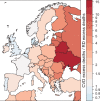Cardiovascular disease burden from ambient air pollution in Europe reassessed using novel hazard ratio functions
- PMID: 30860255
- PMCID: PMC6528157
- DOI: 10.1093/eurheartj/ehz135
Cardiovascular disease burden from ambient air pollution in Europe reassessed using novel hazard ratio functions
Abstract
Aims: Ambient air pollution is a major health risk, leading to respiratory and cardiovascular mortality. A recent Global Exposure Mortality Model, based on an unmatched number of cohort studies in many countries, provides new hazard ratio functions, calling for re-evaluation of the disease burden. Accordingly, we estimated excess cardiovascular mortality attributed to air pollution in Europe.
Methods and results: The new hazard ratio functions have been combined with ambient air pollution exposure data to estimate the impacts in Europe and the 28 countries of the European Union (EU-28). The annual excess mortality rate from ambient air pollution in Europe is 790 000 [95% confidence interval (95% CI) 645 000-934 000], and 659 000 (95% CI 537 000-775 000) in the EU-28. Between 40% and 80% are due to cardiovascular events, which dominate health outcomes. The upper limit includes events attributed to other non-communicable diseases, which are currently not specified. These estimates exceed recent analyses, such as the Global Burden of Disease for 2015, by more than a factor of two. We estimate that air pollution reduces the mean life expectancy in Europe by about 2.2 years with an annual, attributable per capita mortality rate in Europe of 133/100 000 per year.
Conclusion: We provide new data based on novel hazard ratio functions suggesting that the health impacts attributable to ambient air pollution in Europe are substantially higher than previously assumed, though subject to considerable uncertainty. Our results imply that replacing fossil fuels by clean, renewable energy sources could substantially reduce the loss of life expectancy from air pollution.
Keywords: Air pollution; Cardiovascular risk; Excess mortality rate; Fine particulate matter; Health promotion intervention; Loss of life expectancy.
© The Author(s) 2019. Published by Oxford University Press on behalf of the European Society of Cardiology.
Figures





Comment in
-
Estimating pollution-attributable mortality at the regional and global scales: challenges in uncertainty estimation and causal inference.Eur Heart J. 2019 May 21;40(20):1597-1599. doi: 10.1093/eurheartj/ehz200. Eur Heart J. 2019. PMID: 31004133 Free PMC article. No abstract available.
-
Air pollution, chronic smoking, and mortality.Eur Heart J. 2019 Oct 7;40(38):3204. doi: 10.1093/eurheartj/ehz439. Eur Heart J. 2019. PMID: 31230068 No abstract available.
-
Air pollution vs. tobacco smoking.Eur Heart J. 2019 Oct 7;40(38):3202-3203. doi: 10.1093/eurheartj/ehz436. Eur Heart J. 2019. PMID: 31230079 No abstract available.
References
-
- World Health Organization. Global Health Observatory http://www.who.int/gho/en/ (18 October 2018).
-
- European Heart Network. European Cardiovascular Disease Statistics 2017. Brussels, Belgium: EHN; 2017.
-
- Landrigan PJ, Fuller R, Acosta NJR, Adeyi O, Arnold R, Basu N, Baldé AB, Bertollini R, Bose-O’Reilly S, Boufford JI, Breysse PN, Chiles T, Mahidol C, Coll-Seck AM, Cropper ML, Fobil J, Fuster V, Greenstone M, Haines A, Hanrahan D, Hunter D, Khare M, Krupnick A, Lanphear B, Lohani B, Martin K, Mathiasen KV, McTeer MA, Murray CJL, Ndahimananjara JD, Perera F, Potočnik J, Preker AS, Ramesh J, Rockström J, Salinas C, Samson LD, Sandilya K, Sly PD, Smith KR, Steiner A, Stewart RB, Suk WA, van Schayck OCP, Yadama GN, Yumkella K, Zhong M.. The Lancet Commission on pollution and health. Lancet 2018;391:464–512. - PubMed
-
- Brook RD, Rajagopalan S, Pope CA III, Brook JR, Bhatnagar A, Diez-Roux AV, Holguin F, Hong Y, Luepker RV, Mittleman MA, Peters A, Siscovick D, Smith SC Jr, Whitsel L, Kaufman JD; American Heart Association Council on Epidemiology and Prevention, Council on the Kidney in Cardiovascular Disease, and Council on Nutrition, Physical Activity and Metabolism. Particulate matter air pollution and cardiovascular disease: an update to the scientific statement from the American Heart Association. Circulation 2010;121:2331–2378. - PubMed
Publication types
MeSH terms
LinkOut - more resources
Full Text Sources
Other Literature Sources
Medical

